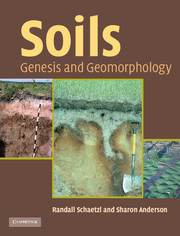Book contents
- Frontmatter
- Contents
- Preface
- Acknowledgements
- Part I The building blocks of the soil
- 1 Introduction
- 2 Basic concepts: soil morphology
- 3 Basic concepts: soil horizonation … the alphabet of soils
- 4 Basic concepts: soil mineralogy
- 5 Basic concepts: soil physics
- 6 Basic concepts: soil organisms
- 7 Soil classification, mapping and maps
- Part II Soil genesis: from parent material to soil
- Part III Soil geomorphology
- References
- Glossary
- Index
6 - Basic concepts: soil organisms
from Part I - The building blocks of the soil
- Frontmatter
- Contents
- Preface
- Acknowledgements
- Part I The building blocks of the soil
- 1 Introduction
- 2 Basic concepts: soil morphology
- 3 Basic concepts: soil horizonation … the alphabet of soils
- 4 Basic concepts: soil mineralogy
- 5 Basic concepts: soil physics
- 6 Basic concepts: soil organisms
- 7 Soil classification, mapping and maps
- Part II Soil genesis: from parent material to soil
- Part III Soil geomorphology
- References
- Glossary
- Index
Summary
Organisms can be classified according to a variety of different criteria. Functional classification schemes group organisms according to their role in the food web (Table 6.1; Fig. 6.1), whereas phylogenetic classification (the basis for the binomial system of scientific names) is based upon organisms' morphology, physiology, habitat and genetic relationships. Living things were originally divided between the plant and animal kingdoms, but organisms are now classified into three domains: Eucarya, Bacteria and Archaea, and seven kingdoms (Woese et al. 1990). Eukaryotes have their genetic material organized inside a nuclear membrane. They can be single-celled (algae, yeasts, most protozoa) or multicellular (most fungi, and all the various plants and animals), and range from primary producers at the bottom of the food web to predatory animals at the top. In contrast, the cells of prokaryotes (bacteria and archaea) lack a nuclear membrane and an organized nucleus. Although important in swamps and the initial colonization of extreme environments, archaea do not play a major role in soil genesis. In this chapter, each of the major groups of soil biota will be introduced, with emphasis on their role in the soil ecosystem. The importance of organisms in soil genesis is discussed more fully elsewhere, especially Chapters 10 and 12.
Primary producers
Primary producers are photosynthetic organisms at the bottom of the food web. Through the process of photosynthesis, they use the sun's energy to convert CO2 into organic compounds and molecular oxygen, both of which are essential for other organisms' survival.
Information
- Type
- Chapter
- Information
- SoilsGenesis and Geomorphology, pp. 93 - 105Publisher: Cambridge University PressPrint publication year: 2005
